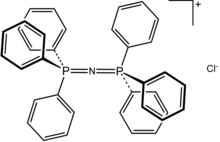|
Bis(triphenylphosphine)iminium chloride
Bis(triphenylphosphine)iminium chloride is the chemical compound with the formula [((C6H5)3P)2N]Cl, often abbreviated [(Ph3P)2N]Cl, where Ph is phenyl C6H5, or even abbreviated [PPN]Cl or [PNP]Cl or PPNCl or PNPCl, where PPN or PNP stands for (Ph3P)2N. This colorless salt is a source of the [(Ph3P)2N]+ cation (abbreviated PPN+ or PNP+), which is used as an unreactive and weakly coordinating cation to isolate reactive anions. [(Ph3P)2N]+ is a phosphazene. Synthesis and structure[(Ph3P)2N]Cl is prepared in two steps from triphenylphosphine Ph3P:[1]
This triphenylphosphine dichloride Ph3PCl2 is related to phosphorus pentachloride PCl5. Treatment of this species with hydroxylamine in the presence of Ph3P results in replacement of the two single P–Cl bonds in Ph3PCl2 by one double P=N bond:
Triphenylphosphine oxide Ph3PO is a by-product. Bis(triphenylphosphine)iminium chloride is described as [(Ph3P)2N]+Cl−. The structure of the bis(triphenylphosphine)iminium cation [(Ph3P)2N]+ is [Ph3P=N=PPh3]+. The P=N=P angle in the cation is flexible, ranging from ~130 to 180° depending on the salt. Bent and linear forms of the P=N=P connections have been observed in the same unit cell.[2] The same shallow potential well for bending is observed in the isoelectronic species bis(triphenylphosphoranylidene)methane, Ph3P=C=PPH3, as well as the more distantly related molecule carbon suboxide, O=C=C=C=O. For the solvent-free chloride salt [(Ph3P)2N]Cl, the P=N=P bond angle was determined to be 133°.[3] The two P=N bonds are equivalent, and their length is 1.597(2) Å.  Use as reagentIn the laboratory, [(Ph3P)2N]Cl is the main precursor to [(Ph3P)2N]+ salts. Using salt metathesis reactions, nitrite, azide, and other small inorganic anions can be obtained with [(Ph3P)2N]+ cations. The resulting salts [(Ph3P)2N]+NO−2, [(Ph3P)2N]+N−3, etc. are soluble in polar organic solvents. [(Ph3P)2N]+ forms crystalline salts with a range of anions that are otherwise difficult to crystallize. Its effectiveness is partially attributable to its rigidity, reflecting the presence of six phenyl rings. Often [(Ph3P)2N]+ forms salts that are more air-stable than salts with smaller cations such as those containing quaternary ammonium cation [NR4]+, or alkali metal cations. This effect is attributed to the steric shielding provided by this voluminous cation. Illustrative [(Ph3P)2N]+ salts of reactive anions include [(Ph3P)2N]+[HFe(CO)4]−, [(Ph3P)2N]+[Co(CO)4]−, ([(Ph3P)2N]+)2[M2(CO)10]2+ (M = Cr, Mo, W), and [(Ph3P)2N]+[Fe(CO)3(NO)]−.[1] The role of ion pairing in chemical reactions is often clarified by examination of the related salt derived from [(Ph3P)2N]+. Related cationsA phosphazenium cation related to [(Ph3P)2N]+ is [(((CH3)2N)3P)2N]+.[4] References
|
||||||||||||||||||||||||||||||||||||||||||||||||||||||||||

